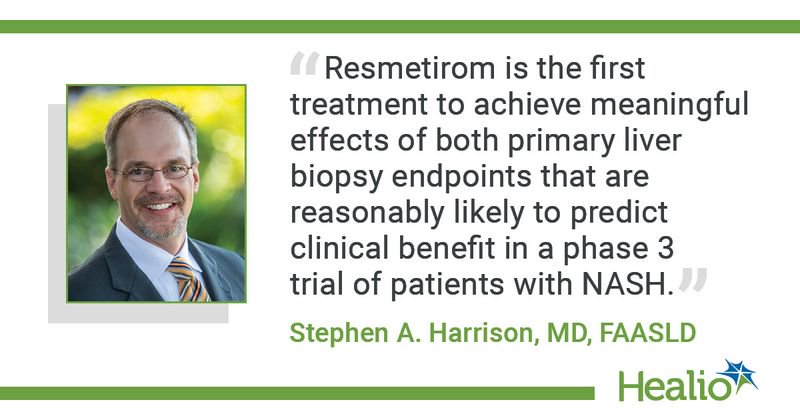Resmetirom achieves ‘meaningful effects’ on NASH resolution, fibrosis stage improvement
Click Here to Manage Email Alerts
Both 80 mg and 100 mg doses of resmetirom achieved liver biopsy endpoints at 52 weeks in patients with nonalcoholic steatohepatitis and had a safety profile consistent with previous reports, according to primary MAESTRO-NASH trial results.
“Resmetirom is an oral, once-daily liver-targeted [thyroid hormone receptor]-beta- selective agonist in development for NASH,” Stephen A. Harrison, MD, FAASLD, from Pinnacle Clinical Research in San Antonio,” said during a presentation at EASL Congress. “In the presence of lipotoxicity, hepatic thyroid function mediated by THR beta is disrupted, impacting lipoprotein metabolism as well as fatty acid oxidation in the liver.”

He continued: “In patients with NASH, selectivity for THR-beta may provide metabolic benefits of thyroid hormone that are mediated by the liver, such as reduction of excess hepatic fat and atherogenic lipids and lipoproteins, while avoiding the negative systematic systemic effects of excess thyroid hormone in heart and bone.”
In the double-blind, randomized, placebo-controlled phase 3 MAESTRO-NASH trial, Harrison and colleagues assessed the efficacy and safety of resmetirom (Madrigal Pharmaceuticals) in 966 patients (mean age, 57 years; 56% women; 90% white) with biopsy-confirmed NASH and stages F1b, F2 or F3 fibrosis. The 54-month trial, which includes patients from nearly 200 sites worldwide, is ongoing.
According to baseline liver biopsy results, 62% of participants were stage F3, 33% stage F2 and 5% stage F1b. Researchers assigned patients to either a low dose (80 mg, n = 316) or a high dose (100 mg, n = 321) of resmetirom or placebo (n = 318).
Liver biopsies were performed at week 52 to assess primary endpoints, which included NASH resolution with no worsening of fibrosis or at least one stage improvement in fibrosis without worsening of nonalcoholic fatty liver disease activity score. Percent reduction in LDL cholesterol also was assessed.
According to primary analysis at week 52, NASH resolution was achieved in 10% of participants treated with placebo, 26% on resmetirom 80 mg and 30% on resmetirom 100 mg. Additionally, at least one stage of fibrosis improvement was met in 14%, 24% and 26%, respectively.
“With placebo,” Harrison said, “approximately twice as many patients progressed and about half as many regressed relative to the two doses of the drug.”
There also was a reduction in LDL cholesterol of 14% in participants on resmetirom 80 mg and 16% on 100 mg.
Additionally, both doses of resmetirom had significant effects on MRI-estimated PDDF and FibroScan CAP at 52 weeks, with 100 mg and 80 mg doses achieving a 51.4 and 42.1 relative reduction in liver fat, respectively, compared with 10 with placebo.
Treatment with resmetirom also had a significant impact on liver and spleen volume and liver stiffness, with FibroScan VCTE measuring a mean change in liver stiffness from 2 to 3.7 kPa with 80 mg and from 2.5 to 3.7 kPa with 100 mg. Reductions in magnetic resonance elastography and enhanced liver fibrosis test were also reported.
Treatment-emergent adverse events were reported in at least 5% of patients overall; however, there were no drug-induced liver injuries. Diarrhea and nausea at the start of dosing were among the most common adverse events associated with treatment.
“Resmetirom is the first treatment to achieve meaningful effects of both primary liver biopsy endpoints that are reasonably likely to predict clinical benefit in a phase 3 trial of patients with NASH,” Harrison said. “Both 80 mg and 100 mg doses were effective, offering optionality for patients. There were multiple supportive analyses and additional data using noninvasive measures, increasing the competence in the liver biopsy data.”

